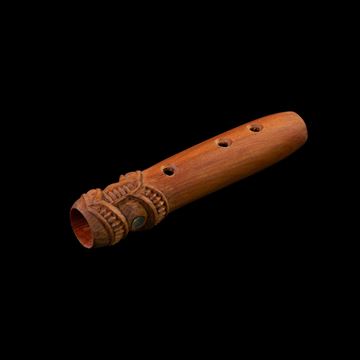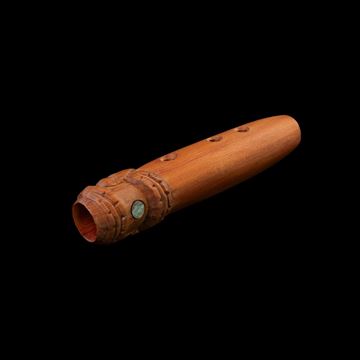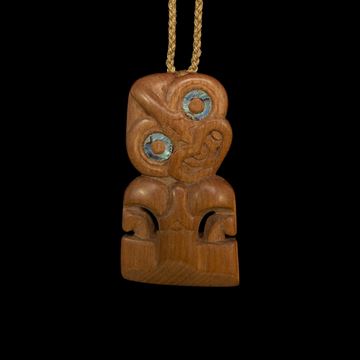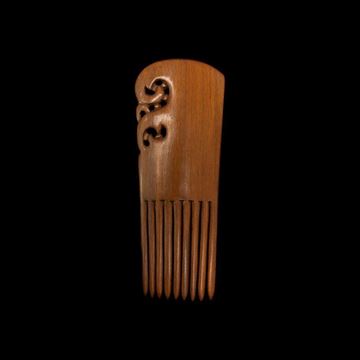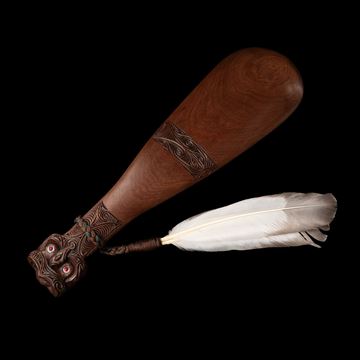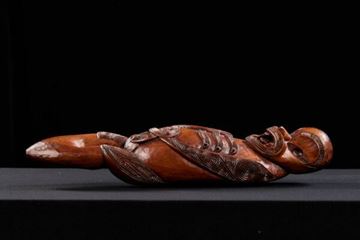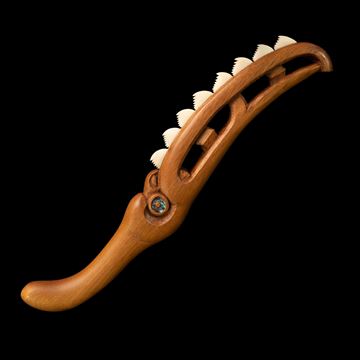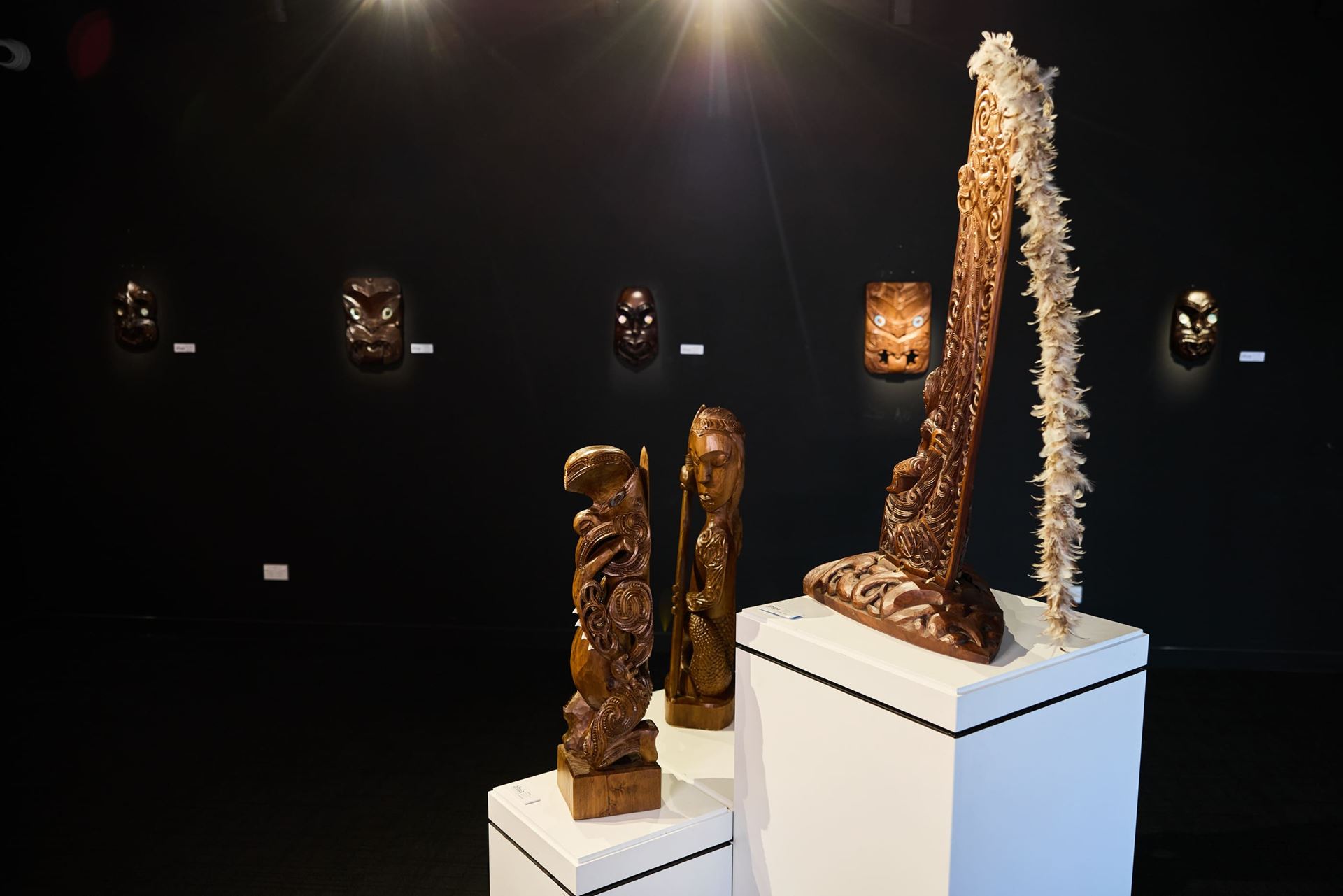
Whakairo Rākau - National Wood Carving School
Since the first intake at Te Wānanga Whakairo, many young Māori from iwi (tribes) throughout New Zealand have been taught the Māori practice of wood carving under the expert guidance of master carvers who were once trainees at the school. This tohu (qualification) is for three years and is 40 hours per week, 47 weeks of the year.
Would you like something custom made just for you? Commission a piece here
Kōauau 5859HY
Kōauau are part of the flute family and come to us from the atua (spiritual entity) of flute music Hine Raukatauri. Kōauau is also the name for a species of hollow kelp, which can also be used to make instruments. Kōauau are made from a variety of different materials including wood, bone or sometimes stone. Most Kōauau have 3 wenewene (finger holes) although there are several older examples that have 4 or more. The kaiwhakangāwari is the wenewene closest to the mouth, the kaiwhakahī is the middle wenewene and the kaiwhakakaha is the wenewene closest to the distal end.
There are many uses for kōauau. In Māori tradition, birds are sometimes seen as important messengers from the spirit world. Kōauau have a reputation of attracting the native birds of Aotearoa. The birds will often interact with the beautiful melody from the kōauau, giving us a glimpse of the spiritual aspects of the kōauau song.
Material: Mataī (NZ Native)
Measurements: 123mm x 26mm x 26mm
$850.00
Kōauau 4439HY
Kōauau are part of the flute family and come to us from the atua (spiritual entity) of flute music Hine Raukatauri. Kōauau is also the name for a species of hollow kelp, which can also be used to make instruments. Kōauau are made from a variety of different materials including wood, bone or sometimes stone. Most kōauau have three wenewene (finger holes) although there are several older examples that have four or more. The kaiwhakangāwari is the wenewene closest to the mouth, the kaiwhakahī is the middle wenewene and the kaiwhakakaha is the wenewene closest to the distal end.
There are many uses for kōauau. In Māori tradition, birds are sometimes seen as important messengers from the spirit world. Kōauau have a reputation of attracting the native birds of Aotearoa. The birds will often interact with the beautiful melody from the kōauau, giving us a glimpse of the spiritual aspects of the kōauau song.
Material: Mataī (NZ Native)
Measurements: 123mm x 26mm x 26mm
$850.00
Hei Tiki - 3147UN
Hei tiki are the best known of all Māori adornments. Tiki are symbols of fertility that depict a new-born child. They are often family heirlooms bearing personal names and embodying their wearers lineage. As with most Māori personal adornments, hei tiki are often passed down generationally.
Material: Rātā
Measurements: 134mm x 70mm x 20mm
$890.00
Hei Tiki - 3148UN
Hei tiki are the best known of all Māori adornments. Tiki are symbols of fertility that depict a new-born child. They are often family heirlooms bearing personal names and embodying their wearers lineage. As with most Māori personal adornments, hei tiki are often passed down generationally.
Material: Rātā
Measurements: 115mm x 64mm x 20mm
$890.00
Heru - 4958CF
Heru were produced in varying shapes and sizes and were made from rākau (wood) and in some instance’s parāoa (whalebone). These combs were highly valued as personal heirlooms and were consequently passed down from one generation to the next, often acquiring their own personal names.
The combs were mostly decorative and held the pūtikitiki (top knot) in place. When a comb was broken, it was placed in a swamp or a sacred place for safe keeping because the head was the most sacred part of the body and therefore tapu (sacred).
Material: Tōtara
Measurements: 230mm x 90mm x 4mm
$2,100.00
Patu - 4797TA
Patu (meaning to strike or hit) were typically fashioned from native hardwood, whalebone, or stone, including our highly valued pounamu (greenstone). Patu were often sharp at their forward edge and were used with thrusting, jabbing, and swinging blows.
Material: Rātā (NZ Native)
Measurements: 360mm x 100mm
$2,200.00
Waka Tūpāpaku - CI3348
A waka tūpāpaku is a box used for containing the bones of a person of high rank after they had been exposed on the atamira platform, the flesh removed and the bones anointed with oil and red ochre, placed in a waka tūpāpaku and taken to a tribal buriel cave.
Material: Tōtara
Measurements: 580mm x 140mm x 110mm
$2,500.00
Māripi - CI3233
Māripi are a traditional meat cutting tool. They are fashioned with a wooden handle and sharks’ teeth carved from Kōiwi (beef bone) to create a serrated edge.
Material: Rātā, Kōiwi (Beef Bone) & Pāua (Abalone)
Measurements: 370mm x 60mm x 30mm
$3,500.00
- 1
- 2

